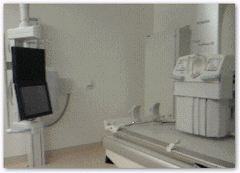We come back around again to the question of both safety and money on this topic and I don’t there’s a doctor around who would hesitate ordering an image if he needed it for a diagnosis, but granted there’s the other side of the coin with a few that see this as an opportunity to increase income.
Of course we need to look at the dose of radiation the patient is exposed to and technology is providing some input there with CT Scanners for one example like the one used at Miller’s Children’s Hospital with 320 bit exposure has a far lower exposure rate than the standard 64 bit used in many facilities.  Note too, the reversal here of the numbers as lower bit always used to mean less exposure and now we have 320 bit with less than 64 bit.
Note too, the reversal here of the numbers as lower bit always used to mean less exposure and now we have 320 bit with less than 64 bit.
320 Bit CT Scanners Offer Less Radiation Exposure Than 64 Bit – New Technology Making the Difference With One Rotation
Now when it comes to cost we have yet one more issue. Back in 2008 companies such as Phillips were in the news with investing in MRI machines that were manufactured in China. Other companies are paying attention to China, too. Siemens last September opened a medical research and development, manufacturing, service, sales, and marketing center in Shanghai.
Chinese MRIs, Coming to Your Hospital
“One of the most aggressive companies is Medtronic (MDT), which in December announced it was investing $221 million to buy a 21% stake in Shandong Weigao Group Medical Polymer, a Hong Kong-listed manufacturer of medical equipment based in China's northeastern Shandong province.”
This ripple effect also continue with the cost as a subsidiary of a major health insurance company has purchased a company in China that already has an open line of communication with the FDA to work with promoting more Chinese medical devices and drugs globally and to here in the US, as it’s not big secret today that insurers are looking at every angle to keep the cost of care and treatment down. When looking at companies as a whole today, it’s important to not forget what the subsidiaries are doing by all means. In this case it is a subsidiary of a subsidiary of United Health Care so a little bit of a trail to chase here but by now we all know that Ingenix is the analytics arm of United with the vast offerings of algorithms all over the map so in essence we are seeing the involvement here of insurance companies taking a stake in getting devices approved from the front side of the game instead of the back side.
UnitedHealth subsidiary (Ingenix Subsidiary I3) Acquires ChinaGate – Working to Sell Chinese Products Globally
From the website:
“We are familiar with the Chinese regulatory system and are well connected with most of the top urban class A hospitals and clinical trial centers that are GCP certified by the China State Food and Drug Administration (SFDA). Moreover, since we worked many years in multi-national pharmaceutical companies ,we are well versed in ICH, European and United States Food and Drug Administration (FDA) requirements on Good Clinical Practice (GCP). “
Again, no doctor is going to shy away from ordering imaging if he/she believes it is in the best interest of the patient and with new devices that have lower exposure rates we are seeing improvement there, but we come back to the cost and how often does a facility buy a new device? Diagnosis still remains a bit of a hit and miss as it has been for years as there’s no 100% methodology out there. Certainly it takes more time as well as the staff time to do the imaging, but when it comes down to the cost, the value of a human life should be first priority as there’s also no doctor under the sun that wants to either miss a diagnosis or risk a malpractice suit as a result. BD
The use of costly advanced imaging techniques in U.S. emergency rooms tripled in a decade, according to a study in the Journal of the American Medical Assn., meaning many more patients were exposed to higher levels of radiation.
Researchers from Johns Hopkins University in Baltimore studied data on emergency room visits from 1998 to 2007, looking for evidence that "excessive use of medical imaging increases healthcare costs and exposure to ionizing radiation (a potential carcinogen) without yielding significant benefits to all patients," according to the JAMA report. They found that, while the use of the scans went from 6 percent of ER visits in 1998 to 17 percent in 2008, there was no corresponding increase in the diagnosis of life-threatening conditions or hospital admissions.
Dr. Raul Uppot, an assistant professor at Harvard Medical School, told the magazine that the study neglected to address a key aspect: The importance of negative results from the scans.
Visits involving the imaging scans took 126 more minutes than visits which didn't involve CT or MRI
Emergency room CT, MRI use triples in 10 years | MassDevice - Medical Device Industry News



0 comments :
Post a Comment